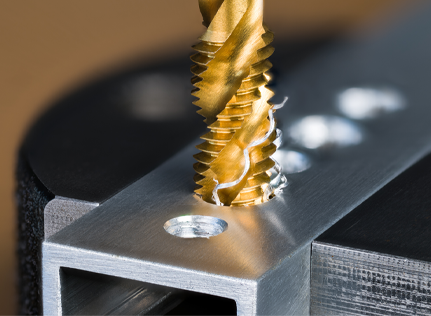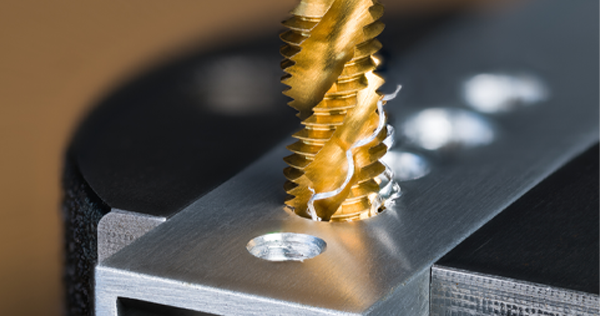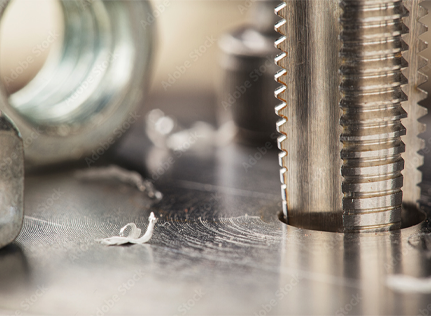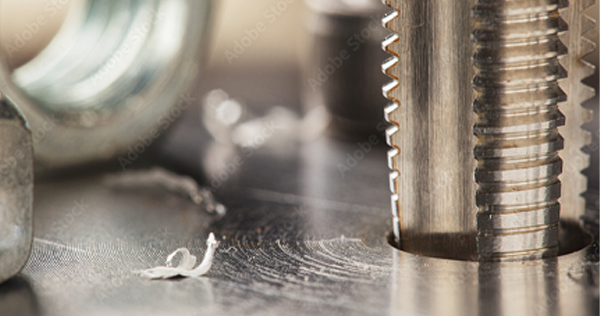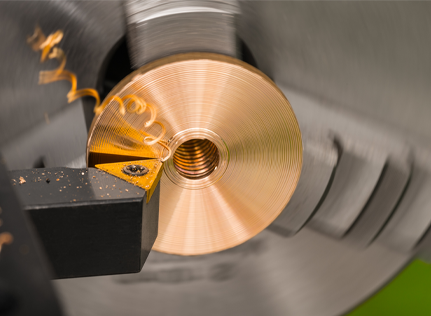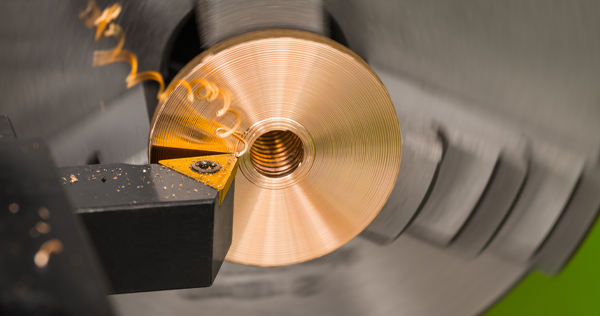Don't have an account?
Creating an account has many benefits: check out faster, keep more than one address, track orders and more.
Or
Checkout as a Guest
Place your order without creating an account for extra convenience.

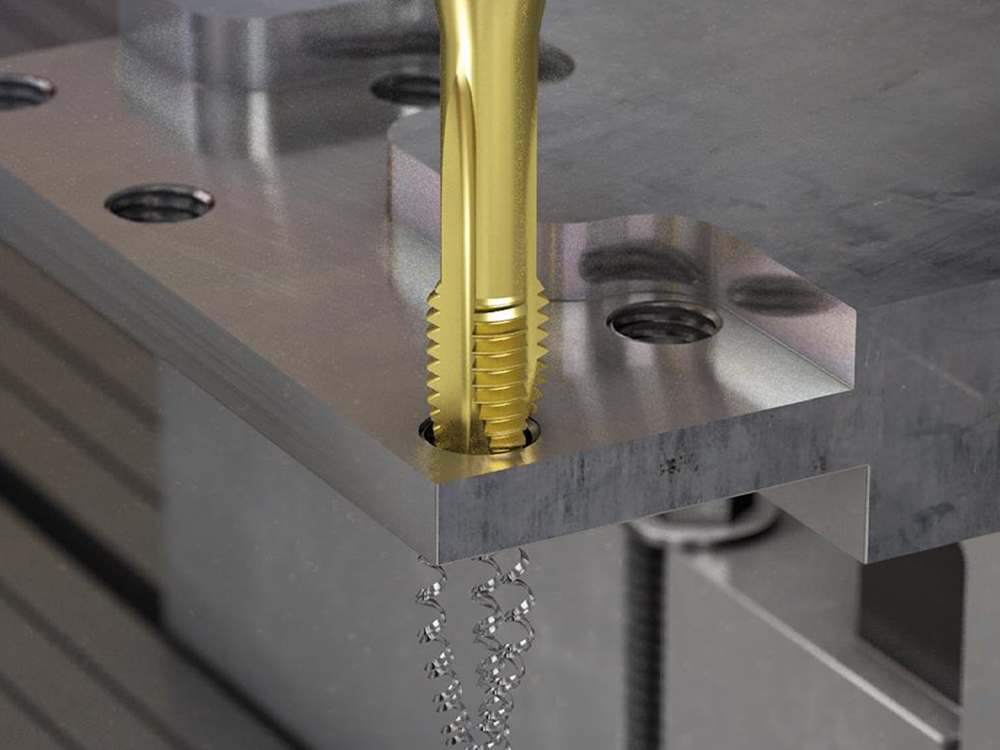
Threading Tools Explained


Daniel Hall
Technical Support
13 years engineering experience, specializing in CNC & manual machining, milling and horizontal bores.
Threading encompasses a range of different tooling and applications. Thread forms, pitch, TPI, diameter, blind hole, through hole, tap, thread mill are all phrases that customers ask me about frequently. So, I've created this blog to compile all the common questions I'm asked...
What is threading?
Threading encompasses a range of applications and processes used to create, or form, a screw thread (commonly shortened to thread) on the surface of a material. A thread refers to a helical structure imposed on a surface which mates with another threaded object (e.g. a screw and a screw nut), usually by rotational force.
The objective of a thread is to bind two mating parts together in a way that they cannot be split without the same force used to bind them being applied in the opposite rotational direction. Often, screw threads are a ridge helically applied around a cylindrical object or workpiece. Outside (external) threads are referred to as male threads, with inside (internal) threads colloquially called female threads. Therefore, male threads will screw into female threads.
Threads are not of uniform shape or dimension. Different thread forms exist to suit different applications and industries, with key differentiators being the thread angle, major and minor diameter, pitch diameter, depth and helix angle. Common thread forms include Metric, UNC/UNF, BSP, BSW, BSPT, NPT/NPTF and Trapezoidal threads. Metric thread forms use the metric measurement system (millimetres, metres etc.), which is widely used in the UK. Most other thread forms (Unified National, British Standard, National Pipe Taper) use the imperial system of measurement (inches).
Metric threading tools measure the distance between each adjacent thread, called the pitch, whereas imperial-based thread tools count the number of threads present within an inch, referred to as TPI. The pitch and TPI are an important measurement used when deciding which threading tool or screw thread insert will best suit an application. These two measurements have an inverse relationship; the smaller a pitch, the finer a thread is. With TPI (threads per inch), the higher the value, the more threads are present within each inch of threaded material; a finer thread.
What are the different types of threading tool?
Most threading tools are designed to perform the same function, which is to create a thread on a given material or surface. How this is achieved, however, is where threading tools differ. Some tools can be used on both a lathe and milling machine, whilst others can only be used on one machine type. Also, some tools must be used by hand and cannot be mechanicalized.
Hand taps are used to create internal threads manually, that is, without any help from a machine. Traditionally, hand taps would be inserted into a tap wrench, which will have a handle at either side which the user can grip whilst creating the thread. Creation happens by the user twisting the tap into the material. Hand taps can be sold either individually or in sets of 3, with a taper, second and plug tap included.
A taper hand tap is used to start the threading process (usually from a pre-drilled pilot hole). The second tap then continues the threading process, with the bottom tap taking you down to the bottom of a blind hole. Hand taps are perfect for softer materials or one-off jobs, but for batch processing or more complex materials, machine tapping is always preferable.
Machine tapping can be performed on either a milling machine (mill) or lathe. Again, their purpose is to create an internal thread through quick rotation of the tool (mill) or workpiece (lathe). There are two common types of machine tap: spiral point and spiral flute. This refers to the type of applications that each machine tap can perform, with spiral point taps used for through holes and spiral flute taps for blind holes. Certain ranges may also feature straight fluted taps for both blind and through hole tapping.
Due to the increased speeds and feeds possible with machine taps versus hand taps, the fluted geometry of machine taps directs chips out of the threaded hole, preventing flute clogging and thread damage. Also, machine taps can machine a much wider range of applications, including difficult materials like titanium, Inconel, hardened steel, stainless steel and abrasive materials. Furthermore, machine taps can feature either a bright finish (ideal for economical machining or when dealing with difficult materials) or various coatings including TiN, TiAlN, nickel or a VAP finish.
Turning to indexable solutions, single point threading (or laydown thread turning) tools feature a steel or carbide shanked holder and replaceable insert. The key benefit of an indexable system over solid systems is that one holder can be used to machine a variety of thread sizes and thread forms, meaning that for engineers who regularly deal with both metric and imperial measurements (like sub-contractors), large cost savings can be found.
Single point threading is almost solely performed on a lathe, with the holder being clamped like a turning tool (for external threading – square shank) or a boring bar (for internal threading – round shank) in a toolpost. Each holder will fit a certain range of sized inserts (e.g. size 11, 16, 22, 27mm), within which will be a range of pitches (or TPI in imperial measurements). Most holders feature a screw clamping system, meaning single point threading inserts can be changed whilst the holder is still within the machine toolpost. Through coolant is also featured in some holders, ideal for effective chip evacuation or where high heat levels are generated during threading.
Thread mills take both solid and indexable form; to cut internal and external threads. As the name suggests, thread mills are designed for use on milling machines. Generally, thread mills are used on NC or CNC machines where helical interpolation and triaxle control functions can be programmed. Compared with machine tapping, the benefits of thread milling is that more precise threads can be created with a superior surface finish (without burrs), with larger diameter threads possible thanks to an indexable offering. In the solid style, various geometries are available depending on the hole size and application.
Helical flute, straight flute and multi-flute are common amongst the standard sized mills. Single tooth and miniature style thread mills are designed for small diameter or long reach applications, with our range starting from just 0.7mm. Through coolant is also possible, with either axial (for blind holes) or radial (for through holes) styles. Indexable thread mills, meanwhile, consist of either a standard or shell mill style (for larger diameters) holder and interchangeable inserts. Unlike thread turning holders, the benefit of indexable holders is the ability to thread larger diameters and thread multiple forms with a single holder. Specific ranges are available with anti-rust, superfast and deep hole threading.

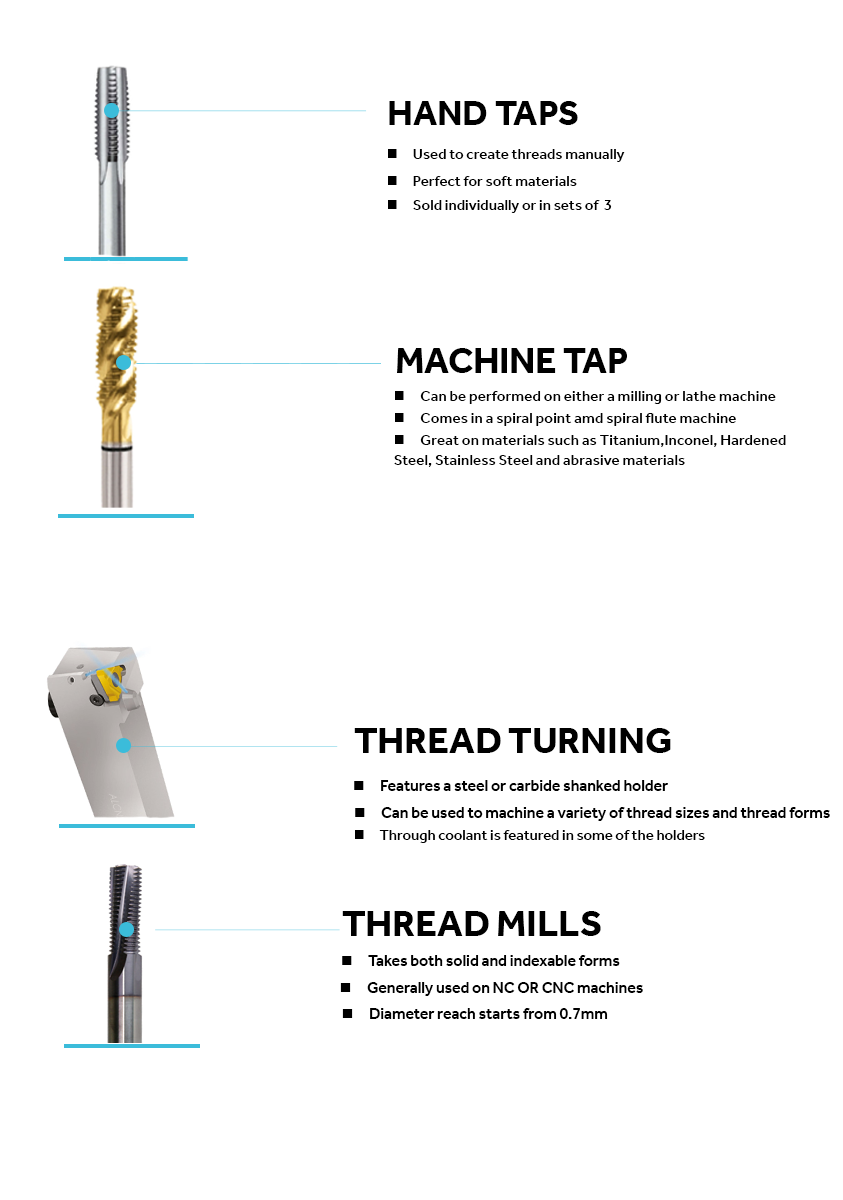
What is the difference between thread turning and thread milling?
Thread milling is performed on a milling machine, with thread turning using a lathe to produce threads. When choosing between the two, this will be the fundamental point which will dictate which option will be used. If both a mill and lathe is available to a user, there are other more subtle differences and benefits to each system which can be used in the decision-making process.
Size of the thread to be produced could also be a consideration. Typically, machine taps are more susceptible to breakages at lower diameters as smaller shanks cannot cope with the higher cutting data. Also, as a tap wears, the chance of breakage increases substantially, which is common amongst these smaller sizes. Thread mills are far more wear resistant and, with their carbide substrate, can withstand these higher feed rates with a much-reduced risk of breakage.
However, such circumstances can also be impacted by the machining set-up, with vibrations significantly reducing the tool life of carbide mills. Meanwhile, thread turning tools are better suited to larger diameter threading applications as it is far more cost-effective to purchase a holder and inserts than a solid carbide thread mill. As thread turning holders are made from steel, they are far cheaper to manufacture and therefore less cost-intensive to the end user.
Other considerations include the quality of thread and complexity of skill required to perform the operation. In general, and partly due to thread mills being better suited to smaller workpieces, thread mills will provide higher quality and more precise threads on workpieces. As thread milling applications are usually programmed on CNC mills, the user can more accurately direct the tool to produce the required thread.
However, there is a trade-off with this, in that the machine operator will need to have more knowledge and programming skills with CAD/CAM software to produce these complex thread milling applications. Thread turning, conversely, can be performed much more simply and in a similar fashion to turning or boring applications. The user must simply set up the threading tool in a lathe toolpost and position the tool towards the workpiece.

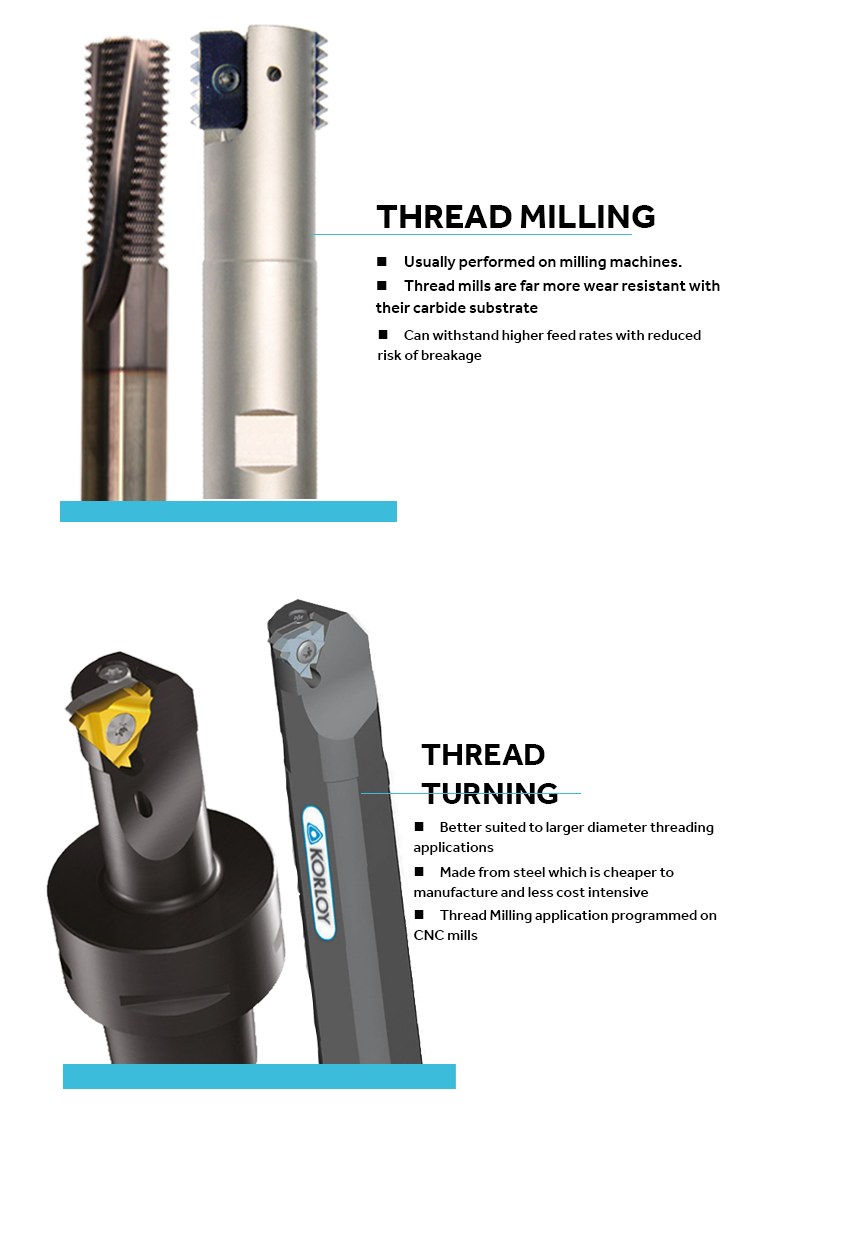
What is the difference between solid and indexable threading tools?
Solid threading tools describe any tool which are made from a singular material, with no parts of the tool being detachable or interchangeable. Once the cutting edge has been worn down, the whole tool will need replacing. An indexable tool features a solid shank on which a replaceable insert acts as a cutting edge which will make contact with the workpiece. When an insert is worn down or chipped, the user can simply unclamp the insert, replace it, and continue machining. In the long run, especially at larger diameters, an indexable tool will provide the most cost benefit to the customer.
Due to the large size of the shank, single point threading (thread turning) holders are indexable. The replaceable insert element is usually made of carbide for extra strength, durability and tool life. Using an indexable system, the insert can be replaced whilst the tool holder remains in the toolpost. Similarly, thread mills are also supplied as indexable systems for larger diameters, but also come in a solid type for smaller sizes starting from under 1mm diameters. Machine and hand taps, due to their low cost, are solely supplied in a solid type.
